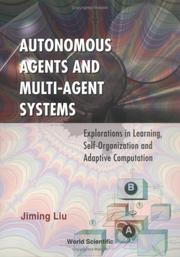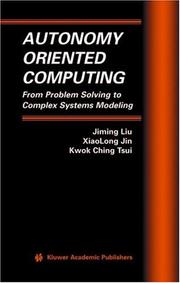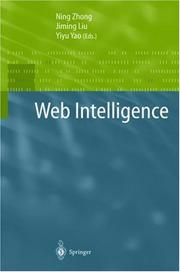| Listing 1 - 10 of 45 | << page >> |
Sort by
|

ISBN: 1281948160 9786611948160 9812797610 9789812797612 9789810245580 9810245580 9781281948168 6611948163 Year: 2001 Publisher: Singapore River Edge, N.J. World Scientific
Abstract | Keywords | Export | Availability | Bookmark
 Loading...
Loading...Choose an application
- Reference Manager
- EndNote
- RefWorks (Direct export to RefWorks)
Agent engineering concerns the development of autonomous computational or physical entities capable of perceiving, reasoning, adapting, learning, cooperating and delegating in a dynamic environment. It is one of the most promising areas of research and development in information technology, computer science and engineering. This book addresses some of the key issues in agent engineering: What is meant by "autonomous agents"? How can we build agents with autonomy? What are the desirable capabilities of agents with respect to surviving (they will not die) and living (they will furthermore enjoy
Artificial intelligence. --- Intelligent agents (Computer software) --- Agents, Autonomous (Computer software) --- Agents, Cognitive (Computer software) --- Agents, Intelligent (Computer software) --- Assistants, Cognitive (Computer software) --- Assistants, Intelligent software --- Autonomous agents (Computer software) --- Cognitive agents (Computer software) --- Cognitive assistants (Computer software) --- IAs (Computer software) --- Intelligent agent software --- Intelligent software agents --- Intelligent software assistants --- Software agents (Computer software) --- Special agents (Computer software) --- Artificial intelligence --- AI (Artificial intelligence) --- Artificial thinking --- Electronic brains --- Intellectronics --- Intelligence, Artificial --- Intelligent machines --- Machine intelligence --- Thinking, Artificial --- Bionics --- Cognitive science --- Digital computer simulation --- Electronic data processing --- Logic machines --- Machine theory --- Self-organizing systems --- Simulation methods --- Fifth generation computers --- Neural computers --- Computer programs --- E-books

ISBN: 1281960748 9786611960742 9812811842 9789812811844 9781281960740 9789810242824 9810242824 Year: 2001 Publisher: Singapore World scientific
Abstract | Keywords | Export | Availability | Bookmark
 Loading...
Loading...Choose an application
- Reference Manager
- EndNote
- RefWorks (Direct export to RefWorks)
An autonomous agent is a computational system that acquires sensory data from its environment and decides by itself how to relate the external stimulus to its behaviors in order to attain certain goals. Responding to different stimuli received from its task environment, the agent may select and exhibit different behavioral patterns. The behavioral patterns may be carefully predefined or dynamically acquired by the agent based on some learning and adaptation mechanism(s). In order to achieve structural flexibility, reliability through redundancy, adaptability, and reconfigurability in real-worl
Intelligent agents (Computer software) --- Self-organizing systems. --- Learning systems (Automatic control) --- Self-optimizing systems --- Cybernetics --- Intellect --- Learning ability --- Synergetics --- Agents, Autonomous (Computer software) --- Agents, Cognitive (Computer software) --- Agents, Intelligent (Computer software) --- Assistants, Cognitive (Computer software) --- Assistants, Intelligent software --- Autonomous agents (Computer software) --- Cognitive agents (Computer software) --- Cognitive assistants (Computer software) --- IAs (Computer software) --- Intelligent agent software --- Intelligent software agents --- Intelligent software assistants --- Software agents (Computer software) --- Special agents (Computer software) --- Artificial intelligence --- Computer programs --- Self-organizing systems --- E-books --- artificiële intelligentie
Book
ISBN: 3030153851 3030153835 Year: 2019 Publisher: Cham : Springer International Publishing : Imprint: Springer,
Abstract | Keywords | Export | Availability | Bookmark
 Loading...
Loading...Choose an application
- Reference Manager
- EndNote
- RefWorks (Direct export to RefWorks)
Healthcare service systems are of profound importance in promoting the public health and wellness of people. This book introduces a data-driven complex systems modeling approach (D2CSM) to systematically understand and improve the essence of healthcare service systems. In particular, this data-driven approach provides new perspectives on health service performance by unveiling the causes for service disparity, such as spatio-temporal variations in wait times across different hospitals. The approach integrates four methods -- Structural Equation Modeling (SEM)-based analysis; integrated projection; service management strategy design and evaluation; and behavior-based autonomy-oriented modeling -- to address respective challenges encountered in performing data analytics and modeling studies on healthcare services. The thrust and uniqueness of this approach lies in the following aspects: Ability to explore underlying complex relationships between observed or latent impact factors and service performance. Ability to predict the changes and demonstrate the corresponding dynamics of service utilization and service performance. Ability to strategically manage service resources with the adaptation of unpredictable patient arrivals. Ability to figure out the working mechanisms that account for certain spatio-temporal patterns of service utilization and performance. To show the practical effectiveness of the proposed systematic approach, this book provides a series of pilot studies within the context of cardiac care in Ontario, Canada. The exemplified studies have unveiled some novel findings, e.g., (1) service accessibility and education may relieve the pressure of population size on service utilization; (2) functionally coupled units may have a certain cross-unit wait-time relationship potentially because of a delay cascade phenomena; (3) strategically allocating time blocks in operating rooms (ORs) based on a feedback mechanism may benefit OR utilization; (4) patients’ and hospitals’ autonomous behavior, and their interactions via wait times may bear the responsible for the emergence of spatio-temporal patterns observed in the real-world cardiac care system. Furthermore, this book presents an intelligent healthcare decision support (iHDS) system, an integrated architecture for implementing the data-driven complex systems modeling approach to developing, analyzing, investigating, supporting and advising healthcare related decisions. In summary, this book provides a data-driven systematic approach for addressing practical decision-support problems confronted in healthcare service management. This approach will provide policy makers, researchers, and practitioners with a practically useful way for examining service utilization and service performance in various ``what-if" scenarios, inspiring the design of effectiveness resource-allocation strategies, and deepening the understanding of the nature of complex healthcare service systems.
Health services administration. --- Health administration --- Health care administration --- Health care management --- Health sciences administration --- Health services management --- Medical care --- Health planning --- Public health administration --- Administration --- Management --- Database management. --- Medical records --- Information Systems Applications (incl. Internet). --- Database Management. --- Health Informatics. --- Data processing. --- EHR systems --- EHR technology --- EHRs (Electronic health records) --- Electronic health records --- Electronic medical records --- EMR systems --- EMRs (Electronic medical records) --- Information storage and retrieval systems --- Data base management --- Data services (Database management) --- Database management services --- DBMS (Computer science) --- Generalized data management systems --- Services, Database management --- Systems, Database management --- Systems, Generalized database management --- Electronic data processing --- Application software. --- Health informatics. --- Clinical informatics --- Health informatics --- Medical information science --- Information science --- Medicine --- Application computer programs --- Application computer software --- Applications software --- Apps (Computer software) --- Computer software --- Data processing
Book
ISBN: 3030521095 3030521079 Year: 2020 Publisher: Cham, Switzerland : Springer,
Abstract | Keywords | Export | Availability | Bookmark
 Loading...
Loading...Choose an application
- Reference Manager
- EndNote
- RefWorks (Direct export to RefWorks)
This book provides a comprehensive introduction to computational epidemiology, highlighting its major methodological paradigms throughout the development of the field while emphasizing the needs for a new paradigm shift in order to most effectively address the increasingly complex real-world challenges in disease control and prevention. Specifically, the book presents the basic concepts, related computational models, and tools that are useful for characterizing disease transmission dynamics with respect to a heterogeneous host population. In addition, it shows how to develop and apply computational methods to tackle the challenges involved in population-level intervention, such as prioritized vaccine allocation. A unique feature of this book is that its examination on the issues of vaccination decision-making is not confined only to the question of how to develop strategic policies on prioritized interventions, as it further approaches the issues from the perspective of individuals, offering a well integrated cost-benefit and social-influence account for voluntary vaccination decisions. One of the most important contributions of this book lies in it offers a blueprint on a novel methodological paradigm in epidemiology, namely, systems epidemiology, with detailed systems modeling principles, as well as practical steps and real-world examples, which can readily be applied in addressing future systems epidemiological challenges. The book is intended to serve as a reference book for researchers and practitioners in the fields of computer science and epidemiology. Together with the provided references on the key concepts, methods, and examples being introduced, the book can also readily be adopted as an introductory text for undergraduate and graduate courses in computational epidemiology as well as systems epidemiology, and as training materials for practitioners and field workers.
Health informatics. --- Health promotion. --- Epidemiology. --- Bioinformatics. --- Health Informatics. --- Health Promotion and Disease Prevention. --- Computational Biology/Bioinformatics. --- Bio-informatics --- Biological informatics --- Biology --- Information science --- Computational biology --- Systems biology --- Diseases --- Public health --- Health promotion programs --- Health promotion services --- Promotion of health --- Wellness programs --- Preventive health services --- Health education --- Clinical informatics --- Health informatics --- Medical information science --- Medicine --- Data processing --- Medical Informatics. --- Computational Biology --- Bio-Informatics --- Biology, Computational --- Computational Molecular Biology --- Bioinformatics --- Molecular Biology, Computational --- Bio Informatics --- Bio-Informatic --- Bioinformatic --- Biologies, Computational Molecular --- Biology, Computational Molecular --- Computational Molecular Biologies --- Molecular Biologies, Computational --- Computational Chemistry --- Genomics --- Disease --- Computer Science, Medical --- Health Informatics --- Health Information Technology --- Informatics, Clinical --- Informatics, Medical --- Information Science, Medical --- Clinical Informatics --- Medical Computer Science --- Medical Information Science --- Health Information Technologies --- Informatics, Health --- Information Technology, Health --- Medical Computer Sciences --- Medical Information Sciences --- Science, Medical Computer --- Technology, Health Information --- Biomedical Technology --- American Recovery and Reinvestment Act --- epidemiology --- Social Epidemiology --- Epidemiologies, Social --- Epidemiology, Social --- Social Epidemiologies --- Epidemiology --- Data processing. --- Computer simulation.
Multi
ISBN: 9783030521097 Year: 2020 Publisher: Cham Springer International Publishing
Abstract | Keywords | Export | Availability | Bookmark
 Loading...
Loading...Choose an application
- Reference Manager
- EndNote
- RefWorks (Direct export to RefWorks)
This book provides a comprehensive introduction to computational epidemiology, highlighting its major methodological paradigms throughout the development of the field while emphasizing the needs for a new paradigm shift in order to most effectively address the increasingly complex real-world challenges in disease control and prevention. Specifically, the book presents the basic concepts, related computational models, and tools that are useful for characterizing disease transmission dynamics with respect to a heterogeneous host population. In addition, it shows how to develop and apply computational methods to tackle the challenges involved in population-level intervention, such as prioritized vaccine allocation. A unique feature of this book is that its examination on the issues of vaccination decision-making is not confined only to the question of how to develop strategic policies on prioritized interventions, as it further approaches the issues from the perspective of individuals, offering a well integrated cost-benefit and social-influence account for voluntary vaccination decisions. One of the most important contributions of this book lies in it offers a blueprint on a novel methodological paradigm in epidemiology, namely, systems epidemiology, with detailed systems modeling principles, as well as practical steps and real-world examples, which can readily be applied in addressing future systems epidemiological challenges. The book is intended to serve as a reference book for researchers and practitioners in the fields of computer science and epidemiology. Together with the provided references on the key concepts, methods, and examples being introduced, the book can also readily be adopted as an introductory text for undergraduate and graduate courses in computational epidemiology as well as systems epidemiology, and as training materials for practitioners and field workers.

ISBN: 084932288X Year: 2001 Publisher: Boca Raton, FL : CRC Press [Chemical Rubber Company],
Abstract | Keywords | Export | Availability | Bookmark
 Loading...
Loading...Choose an application
- Reference Manager
- EndNote
- RefWorks (Direct export to RefWorks)

ISBN: 1402081227 1402081219 1441954805 Year: 2005 Publisher: New York, NY : Springer US : Imprint: Springer,
Abstract | Keywords | Export | Availability | Bookmark
 Loading...
Loading...Choose an application
- Reference Manager
- EndNote
- RefWorks (Direct export to RefWorks)
Autonomy Oriented Computing explores the important theoretical and practical issues in AOC, by analyzing methodologies and presenting experimental case studies. The book serves as a comprehensive reference source for researchers, scientists, engineers, and professionals in all fields concerned with this promising new development in computer science. It can also be used as a main or supplementary text in graduate and undergraduate programs across a broad range of computer-related disciplines, including Robotics and Automation, Amorphous Computing, Image Processing and Computer Vision, Programming Paradigms, Computational Biology, and many others. The first part of the book, Fundamentals, describes the basic concepts and characteristics of an AOC system, and then it enumerates the critical design and engineering issues faced in AOC system development. The second part of the book, AOC in Depth, provides a detailed analysis of methodologies and case studies to evaluate the use of AOC in problem solving and complex system modeling. The final chapter reviews the essential features of the AOC paradigm and outlines a number of possibilities for future research and development. Numerous illustrative examples, experimental case studies, and exercises at the end of each chapter of Autonomy Oriented Computing help particularize and consolidate the methodologies and theories as they are presented.
Mathematics. --- Software engineering. --- Computers. --- Artificial intelligence. --- Computer simulation. --- System theory. --- Systems Theory, Control. --- Artificial Intelligence (incl. Robotics). --- Computing Methodologies. --- Theory of Computation. --- Software Engineering/Programming and Operating Systems. --- Simulation and Modeling. --- Systems, Theory of --- Systems science --- Science --- Computer modeling --- Computer models --- Modeling, Computer --- Models, Computer --- Simulation, Computer --- Electromechanical analogies --- Mathematical models --- Simulation methods --- Model-integrated computing --- AI (Artificial intelligence) --- Artificial thinking --- Electronic brains --- Intellectronics --- Intelligence, Artificial --- Intelligent machines --- Machine intelligence --- Thinking, Artificial --- Bionics --- Cognitive science --- Digital computer simulation --- Electronic data processing --- Logic machines --- Machine theory --- Self-organizing systems --- Fifth generation computers --- Neural computers --- Automatic computers --- Automatic data processors --- Computer hardware --- Computing machines (Computers) --- Electronic calculating-machines --- Electronic computers --- Hardware, Computer --- Computer systems --- Cybernetics --- Calculators --- Cyberspace --- Computer software engineering --- Engineering --- Math --- Philosophy --- Autonomic computing. --- Intelligent agents (Computer software) --- Computational intelligence. --- Problem solving --- Data processing. --- Intelligence, Computational --- Artificial intelligence --- Soft computing --- Agents, Autonomous (Computer software) --- Agents, Cognitive (Computer software) --- Agents, Intelligent (Computer software) --- Assistants, Cognitive (Computer software) --- Assistants, Intelligent software --- Autonomous agents (Computer software) --- Cognitive agents (Computer software) --- Cognitive assistants (Computer software) --- IAs (Computer software) --- Intelligent agent software --- Intelligent software agents --- Intelligent software assistants --- Software agents (Computer software) --- Special agents (Computer software) --- Computer programs --- Information theory. --- Artificial Intelligence. --- Communication theory --- Communication --- Systems theory.

ISBN: 3540443843 3642079369 3662053209 Year: 2003 Publisher: Berlin Springer
Abstract | Keywords | Export | Availability | Bookmark
 Loading...
Loading...Choose an application
- Reference Manager
- EndNote
- RefWorks (Direct export to RefWorks)
Web Intelligence is a new direction for scientific research and development that explores the fundamental roles as well as practical impacts of artificial intelligence and advanced information technology for the next generation of Web-empowered systems, services, and environments. Web Intelligence is regarded as the key research field for the development of the Wisdom Web (including the Semantic Web). As the first book devoted to Web Intelligence, this coherently written multi-author monograph provides a thorough introduction and a systematic overview of this new field. It presents both the current state of research and development as well as application aspects. The book will be a valuable and lasting source of reference for researchers and developers interested in Web Intelligence. Students and developers will additionally appreciate the numerous illustrations and examples.
Artificial intelligence. Robotics. Simulation. Graphics --- Semantic Web --- World Wide Web --- Artificial intelligence --- Web sémantique --- Web --- Intelligence artificielle --- Web sémantique --- Artificial intelligence. --- Application software. --- Information storage and retrieval. --- Mathematical statistics. --- Computer science—Mathematics. --- Information Systems Applications (incl. Internet). --- Information Storage and Retrieval. --- Probability and Statistics in Computer Science. --- Artificial Intelligence. --- Math Applications in Computer Science. --- AI (Artificial intelligence) --- Artificial thinking --- Electronic brains --- Intellectronics --- Intelligence, Artificial --- Intelligent machines --- Machine intelligence --- Thinking, Artificial --- Bionics --- Cognitive science --- Digital computer simulation --- Electronic data processing --- Logic machines --- Machine theory --- Self-organizing systems --- Simulation methods --- Fifth generation computers --- Neural computers --- Mathematics --- Statistical inference --- Statistics, Mathematical --- Statistics --- Probabilities --- Sampling (Statistics) --- Application computer programs --- Application computer software --- Applications software --- Apps (Computer software) --- Computer software --- Statistical methods
Book
ISBN: 9783030521097 Year: 2020 Publisher: Cham Springer International Publishing :Imprint: Springer
Abstract | Keywords | Export | Availability | Bookmark
 Loading...
Loading...Choose an application
- Reference Manager
- EndNote
- RefWorks (Direct export to RefWorks)
Book
ISBN: 9783030153854 Year: 2019 Publisher: Cham Springer International Publishing :Imprint: Springer
Abstract | Keywords | Export | Availability | Bookmark
 Loading...
Loading...Choose an application
- Reference Manager
- EndNote
- RefWorks (Direct export to RefWorks)
| Listing 1 - 10 of 45 | << page >> |
Sort by
|

 Search
Search Feedback
Feedback About UniCat
About UniCat  Help
Help News
News